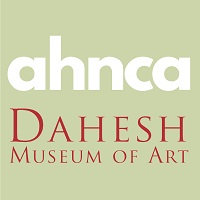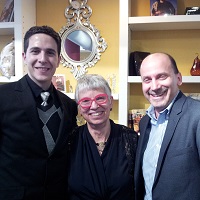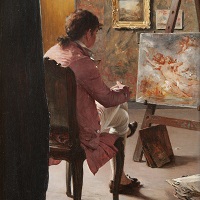- About
- Visit
- Exhibitions
- Collection
- Overview
- Search the Collection
- Recent Acquisitions
- SPOTLIGHT ON …
- Bouguereau’s “Amiable” Pictures Cross the Atlantic
- Back to Work
- The Allure of Animals in Academic Art
- Classical Mythology in 19th-century French Art
- Celebrities: Portrait medals in 19th-Century France
- Oriental “Native Types” from the Dahesh Collection
- Recording Islamic Architecture and Design
- French Natural Selections
- Painting Piety from the Dahesh Collection
- About Face: Learning to Draw Emotion through Expressive Heads
- From St. Petersburg to Paris: The Education of Russian Artists in France
- Picturing the News: The Birth of the Illustrated Press
- Egyptomania: 19th Century Depictions of Ancient Egypt
- The Franco-Prussian War and Its Aftermath in French Art
- Painting Pompeii: From Neoclassicism to the Néo-Grecs
- The Spanish Orient and Henri Regnault (French, 1843–1871)
- Women Artists Who Dared II: Jeanne Thil (French, 1887–1968) and Marie Hadad (Lebanese, 1889–1973)
- Women Artists Who Dared I: Rosa Bonheur (French, 1822–1899) and Elizabeth Gardner Bouguereau (American, 1837–1922)
- Peder Mork Mønsted’s (Danish, 1859–1941) Poetic Views of Nature
- Publications
- Programs
- Shop
- News
Search Results for: ‘asiel sepulveda’
-
ASIEL SEPÚLVEDA AWARDED BEST PAPER PRIZE AT TWELFTH ANNUAL GRADUATE STUDENT SYMPOSIUM IN NINETEENTH-CENTURY ART
— Event Co-Sponsored By The Dahesh Museum Of Art
And The Association Of Historians Of Nineteenth-Century Art —
New York, March 24, 2015 – Asiel Sepúlveda, a student at Southern Methodist University, won the Dahesh Museum of Art Prize for Best Paper at the 12th Annual Graduate Student Symposium in Nineteenth-Century Art, co-sponsored by the Dahesh Museum of Art and the Association of Historians of Nineteenth-Century Art (AHNCA), an organization designed to foster dialogue and communication among those who have a special interest in this field of nineteenth-century art and culture.
Sepúlveda’s paper, “Visualizing the Urban Environment: The Mulata and Tobacco Lithography in Mid-Nineteenth Century Havana,” examined how Havana’s mid-nineteenth century tobacco manufacturers employed printed ephemera and costumbrista types, such as the mulata, to portray African female sexuality as a disruptive force clashing with modernizing notions of cleanliness (both urban and racial), morality, and civil order in the midst of urban reformation. The winning entry will appear in an upcoming issue of Nineteenth Century Art Worldwide e-journal (http://www.19thc-artworldwide.org); the Best Paper prize is $1000, a gift from the Mervat Zahid Foundation.
“The papers presented at the symposium further demonstrate how young scholars continue to find new and innovative means of interpreting the nineteenth century,” said Alia Nour, Curator at the Dahesh Museum of Art. “We are indebted to these young people for continually revitalizing a field of study that attracts more and more scholars.”
The 2015 jury included Nebahat Avcıoğlu, Petra ten-Doesschate Chu, Marilyn Satin Kushner, Patricia Mainardi, and Peter Trippi; the symposium committee includee Caterina Pierre, Margaret Samu, and Mary Frances Zawadzki.
About the Dahesh Museum of Art
The Dahesh Museum of Art is the only institution in the United States devoted to collecting, exhibiting, and interpreting works by Europe and America’s academically trained artists of the 19th and early 20th centuries. The Dahesh serves a diverse audience by placing these artists in the broader context of 19th-century visual culture, and by offering a fresh appraisal of the role academies played in reinvigorating the classical ideals of beauty, humanism, and skill. Visit us at: http://www.daheshmuseum.org.
# # #
-
Virtual Salon – Art of the Americas: Global Perspectives

Please join us on Wednesday, November 17, at 7PM ET for Art of the Americas: Global Perspectives, the November Virtual Salon co-sponsored by the Association of Historians of Nineteenth-Century Art (AHNCA) and the Dahesh Museum of Art. This online event is free and open to the public, but registration is required at https://tinyurl.com/americas19.
For this event, we are fortunate to host three specialists who will discuss this increasingly important area of nineteenth-century studies: Asiel Sepúlveda (Moderator), Katherine Manthorne, and Emmanuel Ortega. Their discussion will be followed by a Q&A and then a break-out room where attendees can socialize informally.
Asiel Sepúlveda is Assistant Professor of Art History at Simmons University. His research focuses on print culture in the nineteenth-century Caribbean. In 2015, he received the Dahesh Museum of Art Prize for the Best Paper at the 12th Annual Graduate Student Symposium in Nineteenth-Century Art, subsequently published in Nineteenth-Century Art Worldwide (Autumn 2015) as “Humor and Social Hygiene in Havana’s Nineteenth-Century Cigarette Marquillas.” He is currently editing a book-length project entitled “Havana Impressions: Print Culture and Global Modernity in Plantation Cuba (1790–1860),” which explores the urban imagery of the Cuban plantation system through the lens of print studies and global art histories.
Katherine Manthorne, a specialist in modern art of the Americas, is Professor of Art History at the Graduate Center of the City University of New York; prior to that, she was the Director of the Research Center at the Smithsonian American Art Museum. Her scholarship has long focused on the landscape and hemispheric dimensions of American art, beginning with Tropical Renaissance: North American Artists Exploring Latin America, 1839–1879 (1989) and continuing in California Mexicana: Missions to Murals, 1820 to 1930 (2017) and Traveler Artists: Landscapes of Latin America from the Patricia Phelps de Cisneros Collection (2015). Women artists are featured in two recent books: Women in the Dark: American Female Photographers 1850–1900 (2020) and Restless Enterprise: The Art and Life of Eliza Pratt Greatorex (2020).
Emmanuel Ortega is the Marilynn Thoma Scholar in Art of the Spanish Americas, and an Assistant Professor of Art History at the University of Illinois at Chicago. He specializes in the topic of sentimentality as it pertains to nineteenth-century Mexico, and Novohispanic Franciscan portraiture. His essay “The Mexican Picturesque and the Sentimental Nation: A Study in Nineteenth-Century Landscape” was published in the Art Bulletin (June 2021). He is co-producer of the YouTube channel Unsettling Journeys and a recurrent lecturer for the Arquetopia Foundation for Development, the largest artist residency in México.
-
DAHESH MUSEUM OF ART CO-SPONSORS THE TWELFTH ANNUAL GRADUATE STUDENT SYMPOSIUM IN NINETEENTH-CENTURY ART
(Symposium Will Take Place Sunday, March 22, 2015, at the Dahesh Museum of Art Gift Shop).
New York, March 16, 2015 – The Graduate Student Symposium in Nineteenths-Century Art, co-sponsored by the Dahesh Museum of Art, will take place on Sunday, March 22, from 10:00 AM-to-5:00 PM at the Dahesh Museum of Art Gift Shop, 145 Sixth Avenue, on the corner of Dominick Street, one block south of Spring Street. The Museum will also present the Dahesh Museum of Art Prize for the Best Paper, a gift from the Mervat Zahid Cultural Foundation. The event is open to the public; reservations are recommended but not required.
“The nineteenth century continues to attract increased academic attention and world-class scholarship,” said J. David Farmer, Director of Exhibitions at the Dahesh Museum of Art. “Every year this symposium presents new and intriguing papers on diverse subjects within our realm of study and expertise. We are proud of the work these young scholars are producing and look forward to helping them lead the discussion on the importance of the nineteenth century.”
The Symposium is co-sponsored by the Association of Historians of Nineteenth-Century Art (AHNCA), an organization designed to foster dialogue and communication among those who have a special interest in this field of nineteenth-century art and culture. The 2015 jury consists of Nebahat Avcıoğlu, Petra ten-Doesschate Chu, Marilyn Satin Kushner, Patricia Mainardi, and Peter Trippi; the symposium committee includes Caterina Pierre, Margaret Samu, and Mary Frances Zawadzki.
SYMPOSIUM HIGHLIGHTS
10 AM: Welcome Presentation
Peter Trippi (President, Association of Historians of Nineteenth-Century Art)
10:15 AM – 11:15 AM: First Morning Session & Discussion
Patricia Mainardi (Program Chair, Association of Historians of Nineteenth-Century Art, & The Graduate Center, City University of New York), Moderator
Tamar Mayer, University of Chicago, “From Ancient to Modern Heroes: Transformations in Jacques-Louis David’s Preparatory Drawing Procedures”
In the early 1800s, Jacques-Louis David’s grand historical paintings no longer depicted classical themes but represented contemporary political events. In this paper, Tamar Mayer argues that this shift—from ancient to modern heroes—reflects decisive transformations in David’s preparatory drawing practices as well.
11:30 AM – 12:15 PM: Second Morning Session & Discussion
Peter Trippi (President, Association of Historians of Nineteenth-Century Art), Moderator
Sophie Lynford, Yale University, “Spiritualism in Landscape Painting and Photography: William Stillman’s Quest for Truth in Nature”
Considered the first American Pre-Raphaelite painter, William Stillman engaged multiple intellectual currents, including Ruskinian fidelity to nature, Transcendentalism, and Hudson River School aesthetics. In this paper, Sophie Lynford pays particularly close attention to Stillman’s participation in antebellum Spiritualism, arguing that his commitment to Spiritualist theory and practice found formal expression in his painting and, later, in his photography.
Alice J. Walkiewicz, The Graduate Center, City University of New York, “Transforming ‘The Song of the Shirt’: The Seamstress in Late Victorian Art”
Through the visual representation of working-class seamstresses, Alice Walkiewicz explores the relationship between labor reform and art production in late-19th-century Britain — a watershed moment in social history, when gender and labor issues were hotly debated as women increasingly sought employment outside the home, and industrialization changed the nature of work.
2:00 PM – 3:30 PM: First Afternoon Session & Discussion
Marilyn Satin Kushner (New-York Historical Society), Moderator
Emily Doucet, University of Toronto, “Anticipating Machines Heavier Than Air: Nadar, Photography and the Objects of Technology”
Emily Doucet examines a series of photographs taken by Nadar in 1863, featuring several model helicopters developed by Gustave Ponton d’Amécourt. Like the extensive technological description included in proto-science fiction literary texts of the same period, these images embody a mode of speculative fiction imagining a future in flight for machines heavier than air.
Nora Labo, University of St. Andrews, Scotland, “‘Can’t See the Forest for the Trees’: Jacques Huber’s Arboretum Amazonicum (1900-1906): The Difficulties of Representing Amazonian Complexity”
By examining a confusing and heterogeneous late-nineteenth-century portfolio of scientific nature photographs, Nora Labo will focus on the contradictions inherent in the colonial perceptions of Amazonia, and on the complex negotiations at work in the symbolic organization of a type of landscape which seemed to resist European ideas of order and rationality.
Giorgi Papashvili, Tbilisi State Academy of Arts, Georgia, “Gabashvili’s Art: Nationalism or Orientalism?”
The painter Giorgi Gabashvili (1862-1936) is known to the Western world as an Orientalist, but in Eastern Europe as the founder of Georgian Realist painting. Giorgi Papashvili will analyze his work in both Eastern and Western cultural contexts, including Orientalism, photography, ethnography, and nationalism.
3:45 PM – 4:45 PM: Second Afternoon Session & Discussion
(Nebahat Avcıoğlu, Hunter College, City University of New York), Moderator
Asiel Sepúlveda, Southern Methodist University, “Visualizing the Urban Environment: The Mulata and Tobacco Lithography in Mid-Nineteenth Century Havana”
Asiel Sepúlveda examines how Havana’s mid-nineteenth century tobacco manufacturers employed printed ephemera and costumbrista types, such as the mulata, to portray African female sexuality as a disruptive force clashing with modernizing notions of cleanliness (both urban and racial), morality, and civil order in the midst of urban reformation.
Maika Pollack, Princeton University, “‘Unconscious Nature’: Odilon Redon’s Portraits of La Femme Nouvelle, 1899-1910”
Redon’s pastels of women deploy non-local color as a new means of representing the femme nouvelle. Often Redon has been described as reactionary in the face of changing gender roles; Maika Pollack argues instead that these theosophically-inspired portraits depict female sitters with unprecedented subjectivity. Their luminous colors have implications for the development of painterly abstraction.
About the Dahesh Museum of Art
The Dahesh Museum of Art is the only institution in the United States devoted to collecting, exhibiting, and interpreting works by Europe and America’s academically trained artists of the 19th and early 20th centuries. The Dahesh serves a diverse audience by placing these artists in the broader context of 19th-century visual culture, and by offering a fresh appraisal of the role academies played in reinvigorating the classical ideals of beauty, humanism, and skill. Visit us at: http://www.daheshmuseum.org.
# # #





